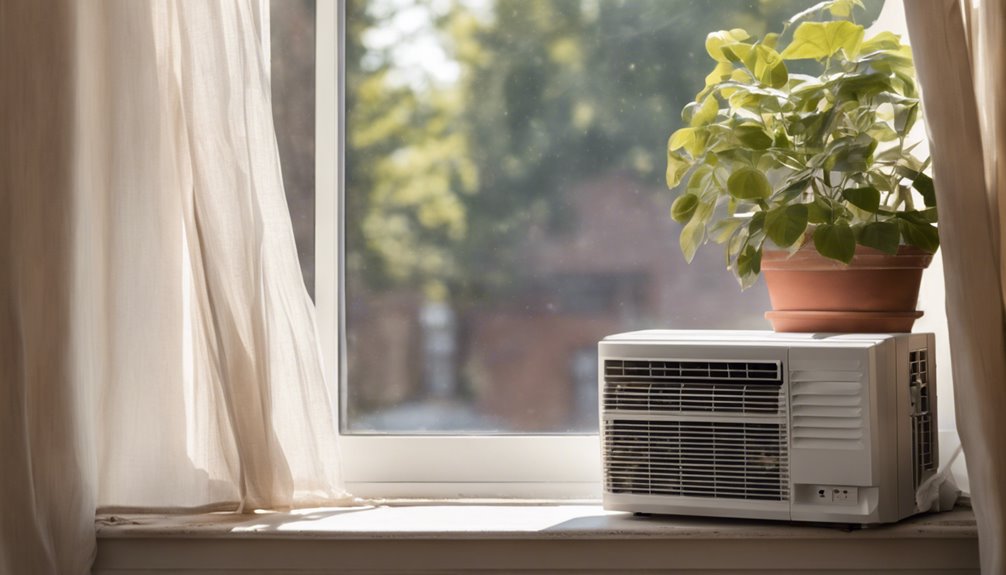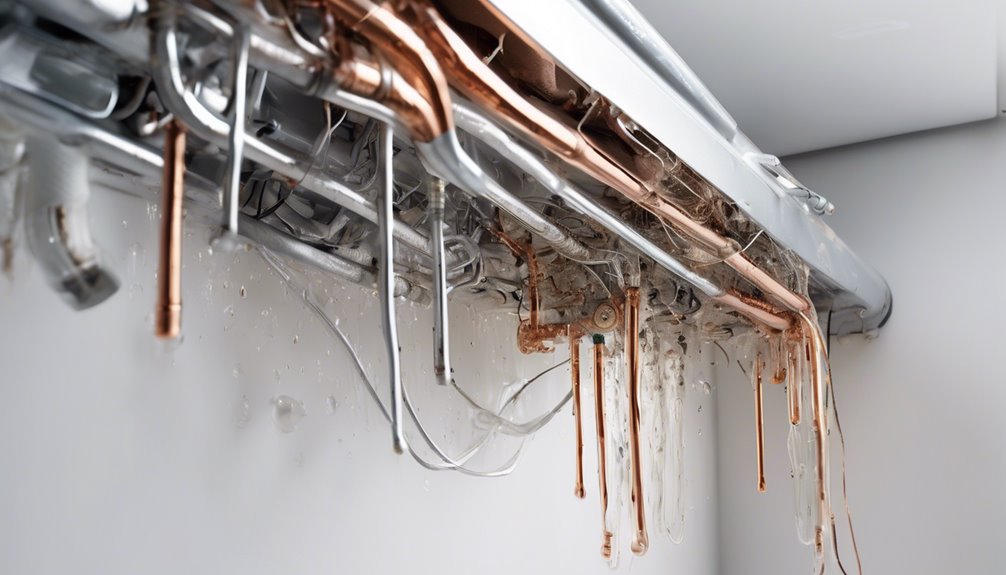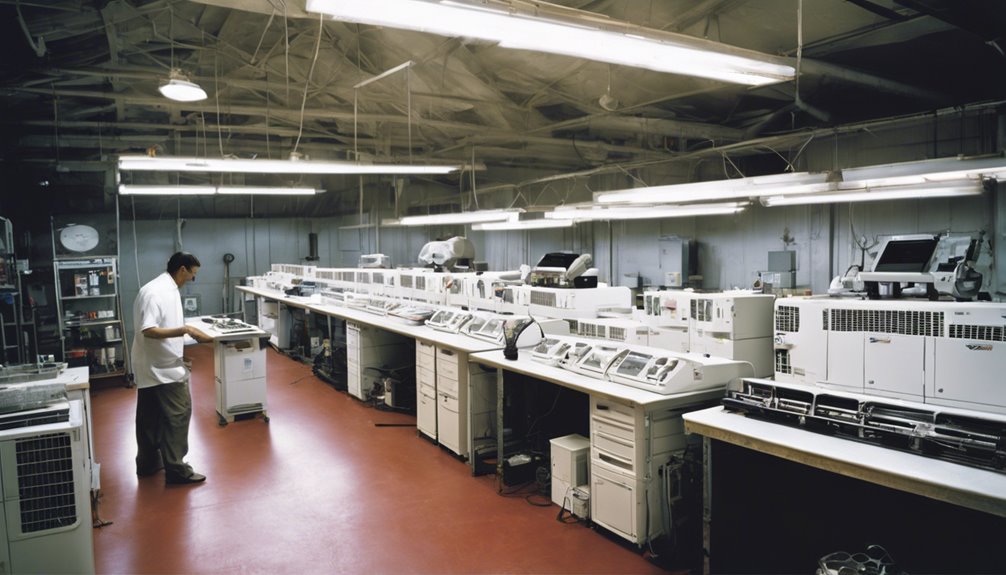You're smart to wonder about average window AC maintenance costs and tips, since neglecting regular upkeep can lead to higher energy bills, reduced airflow, and even premature unit failure. Regular maintenance can help extend the life of your unit, reduce energy bills, and even prevent water damage. On average, maintenance costs can range from $50 to $200 per year, depending on the complexity of the task and your location. By staying on top of maintenance, you'll not only save money but also ensure a healthy and safe indoor environment – and there's more to learn about making the most of your window AC.
Key Takeaways
- Regular window AC maintenance can cost between $50 to $200 per year, depending on the type of service and frequency.
- Cleaning the filter and coils regularly can help reduce maintenance costs by up to 30% and increase energy efficiency.
- Scheduling professional maintenance can help identify potential issues early, reducing the likelihood of costly repairs and replacements.
- Performing DIY maintenance tasks, such as cleaning the filter and coils, can save up to $100 per year on maintenance costs.
- Neglecting regular maintenance can lead to a 10-20% increase in energy bills and reduce the unit's lifespan by up to 50%.
Understanding Window AC Maintenance Needs
About 75% of window air conditioning unit failures can be attributed to poor maintenance.
You might think it's a hassle, but regular upkeep is crucial to extending the life of your unit. When you neglect maintenance, you're not only risking breakdowns, but also reducing energy efficiency.
A well-maintained window AC unit consumes less power and saves you money on your electricity bill.
Start by performing a unit inspection every few months. Check for signs of wear, rust, or damage.
Ensure all screws and bolts are tightened, and the unit is properly installed.
Cleaning the Filter and Coils
You'll want to start by cleaning the filter, which can be done by gently vacuuming it or soaking it in warm soapy water.
Next, turn your attention to the coils, making sure to remove any debris that's accumulated on them. By keeping these components clean, you'll help your window AC run more efficiently and effectively.
Filter Cleaning Methods
Cleaning your window AC's filter and coils regularly is crucial for maintaining its performance and energy efficiency.
You'll typically find two types of filters in window ACs: disposable fiberglass filters and reusable electrostatic filters. Disposable filters should be replaced every 1-2 months, while reusable filters can be cleaned and reused.
To clean your reusable filter, gently tap it to remove loose dust, then wash it with mild soap and warm water. Rinse thoroughly and let it air dry before reinstalling.
When comparing filter types, consider that reusable filters are more eco-friendly and cost-effective in the long run, but may require more maintenance. By cleaning your filter regularly, you'll breathe easier and save on energy costs.
Coil Maintenance Tips
Your window AC's coils play a critical role in heat transfer, and dirty coils can increase your energy bills and reduce the unit's overall performance.
To ensure optimal performance, you need to prioritize coil maintenance. Regular coil inspection is essential to identify any damage or dirt buildup.
For effective coil protection, follow these tips:
- Use a soft brush to gently remove dirt and debris from the coils
- Mix baking soda and water to create a paste, and apply it to the coils to remove stubborn dirt
- Use a garden hose to rinse the coils, but avoid using a high-pressure washer
- Dry the coils with a clean towel to prevent water spots
- Consider applying a coil cleaning solution for tough dirt buildup
Debris Removal Essentials
Dust, dirt, and debris can wreak havoc on your window AC's performance, causing it to work harder and consume more energy.
To prevent this, you'll need to remove debris from your AC's filter and coils regularly. Start by turning off your AC and removing the filter. Gently vacuum or wash it with soap and warm water.
Next, inspect the coils for outdoor hazards like leaves or twigs. Use a soft brush or vacuum to remove any debris.
Don't forget to perform ventilation checks to ensure proper airflow. By removing debris and ensuring good airflow, you'll improve your AC's efficiency and prolong its lifespan.
Checking and Replacing Air Filters
The air filter in your window AC plays a crucial role in maintaining good air quality and overall system performance.
A dirty filter can lead to increased energy bills, reduced airflow, and even system breakdowns. You should check and replace your air filter every 1-3 months, depending on filter durability and usage.
- Check your filter ratings to determine the right replacement schedule for your unit.
- Look for filters with high MERV ratings for better air quality.
- Clean or replace filters according to the manufacturer's instructions.
- Use a soft brush or vacuum to gently remove dirt and debris from the filter.
- Keep a spare filter on hand to avoid delays in replacement.
Inspecting and Cleaning the Condenser Coils
When you're inspecting and cleaning the condenser coils, you'll typically find them located on the back or bottom of your window AC unit.
You'll want to remove any visible dust and debris that's accumulated, as it can hinder airflow and reduce the unit's efficiency.
Be gentle when cleaning the coils, as they can be easily damaged, and make sure to use a soft brush or cloth to wipe away dirt and grime.
Coil Location Matters
Position your window AC to ensure the condenser coils, typically located at the back or bottom of the unit, receive adequate airflow.
This is crucial because poor coil location can lead to reduced performance and increased energy bills.
When deciding where to place your window AC, consider the following factors to ensure coil accessibility and minimize outdoor obstructions:
- Keep the unit at least 3 feet away from any walls or obstructions to allow for proper airflow.
- Avoid placing the AC near bushes, trees, or other foliage that could block airflow or debris.
- Ensure the AC is installed on a level surface to prevent uneven airflow.
- Don't place the AC near sources of heat, such as radiators or heaters.
- Consider installing the AC on a wall with a northern or eastern exposure to reduce direct sunlight.
Dust and Debris Removal
Dust and debris accumulating on your window AC's condenser coils can significantly reduce its performance and energy efficiency.
You'll want to inspect the coils regularly to ensure they're free from obstructions. Start by turning off the power to the unit and removing the grille or filter. Locate the condenser coils, usually found on the back or bottom of the AC.
Gently vacuum the coils with a soft-bristled brush or a specialized coil cleaning brush to remove any visible dust or debris. This will improve air intake and ventilation systems, allowing your window AC to breathe more easily and operate at its best.
Gentle Cleaning Methods
You'll want to adopt gentle cleaning methods when inspecting and cleaning the condenser coils to avoid damaging the delicate fins or pushing debris further into the coils.
Harsh chemicals or rough scrubbers can cause more harm than good, so it's essential to be gentle.
To clean the condenser coils effectively, try the following methods:
- Use soft brushes to sweep away loose debris and dust
- Gently vacuum the coils with a soft-bristled brush attachment
- Dampen a cloth with water and wipe down the coils to remove dirt and grime
- Mix baking soda and water to create a paste, then apply it to the coils and let it sit before rinsing off
- For tough stains, use a mild detergent and warm water, but avoid using high-pressure hoses or harsh chemicals
Verifying Proper Installation and Sealing
Proper installation and sealing of your window air conditioner are crucial to its efficient operation and longevity.
To ensure this, you should create an installation checklist to verify that your unit is correctly installed. This checklist should include items like ensuring the AC is level, securely fastened, and properly aligned with the window.
Next, perform a sealing inspection to identify any gaps or cracks where warm air can enter or cool air can escape. Check the weatherstripping and replace it if necessary. Also, inspect the window sash and frame for any signs of damage or wear.
Lubricating Moving Parts
With your window air conditioner properly installed and sealed, it's time to focus on keeping its moving parts well-lubricated.
This is crucial for ensuring silent operation and reducing motor wear.
You can do this by applying a few drops of lubricant to the fan motor bearings and other moving parts.
- Fan motor bearings: Apply a few drops of lubricant to the bearings to reduce friction and wear.
- Compressor piston rings: Lubricate the piston rings to reduce friction and prevent overheating.
- Fan blades: Clean and lubricate the fan blades to ensure smooth rotation.
- Pivot points: Apply lubricant to pivot points, such as the fan blade axes, to reduce friction.
- Gaskets and seals: Inspect and lubricate gaskets and seals to prevent wear and leakage.
Checking Refrigerant Leaks and Levels
Your window air conditioner's refrigerant plays a crucial role in cooling your space, and even a small leak can significantly impact its performance.
To ensure your window AC runs efficiently, you'll need to perform a refrigerant check regularly. This involves inspecting the unit's refrigerant lines, fittings, and connections for signs of leaks or damage.
You can use a leak detection kit or hire a professional to do it for you. If you find a leak, you'll need to have it repaired by a licensed technician.
Maintaining Proper Drainage
The condensate drainage system of your window air conditioner is responsible for removing excess water that accumulates during the cooling process.
If it's not functioning correctly, you'll face drainage issues that can lead to water damage and further complications.
To avoid these problems, make sure to:
- Check the drainage tube for blockages or kinks
- Ensure the AC is installed at the correct angle to allow proper drainage
- Clean the condenser coils to prevent water from accumulating
- Check the drainage pan for rust or corrosion and replace it if necessary
- Verify that the window kit is properly sealed to prevent water from seeping in
Scheduling Professional Maintenance
Proper drainage is just one aspect of maintaining your window air conditioner. To keep your unit running efficiently and effectively, you'll want to schedule professional maintenance. This can be especially important if you're not comfortable performing routine tasks yourself.
| Maintenance Option | Description |
|---|---|
| Seasonal schedules | Schedule maintenance at the start and end of each cooling season to ensure your unit is running at peak performance. |
| Maintenance contracts | Consider entering into a contract with a professional to perform routine maintenance tasks for a set fee. |
| One-time visits | If you're not interested in a contract, you can still schedule a one-time visit from a professional to inspect and maintain your unit. |
| Preventative maintenance | Regular maintenance can help prevent costly repairs down the line. |
| Customized plans | Work with a professional to create a customized maintenance plan that meets your specific needs and budget. |
Frequently Asked Questions
Can I Use a Vacuum to Clean My Window Ac's Condenser Coils?
You can use a vacuum to clean your window AC's condenser coils, but be cautious not to push too hard, as coils can bend easily. Vacuum efficiency is key; use a gentle suction setting to remove dust and debris for effective coil cleaning.
How Often Should I Replace My Window Ac's Air Filter?
You should replace your window AC's air filter every 1-3 months, depending on filter quality and type. Look for filters with high MERV ratings, and consider washable filters for eco-friendliness, but replace them as recommended to ensure optimal airflow and performance.
Will Regular Maintenance Void My Window Ac's Warranty?
You're wise to wonder if regular maintenance will void your window AC's warranty. Check your warranty terms to ensure DIY cleaning and filter replacements won't nullify it; some manufacturers require warranty checks before performing maintenance tasks.
Can I Install a Window AC in a Casement Window?
You can't install a window AC in a casement window since it requires a horizontal sliding window for proper installation; consider alternative window types like double-hung or sliding windows for a secure and efficient setup.
Do Window ACS Need to Be Covered During Winter?
You'll want to cover your window AC during winter to protect it from harsh weather. Look into winter storage options, like a cover or storage bag, to keep it clean and dry. This also provides insulation benefits, reducing heat loss and energy bills.
Conclusion
You've made it through the list of window AC maintenance tasks! By following these simple steps, you'll be able to keep your unit running efficiently and effectively. Remember to stay on top of filter cleaning, coil inspections, and refrigerant checks to avoid costly repairs down the line. With regular maintenance, you can enjoy a cool and comfortable home while saving money on your energy bills.



